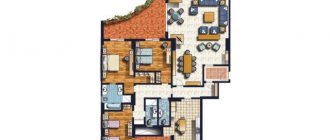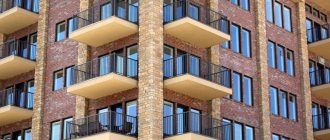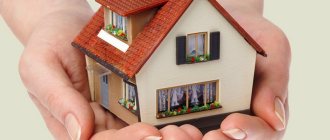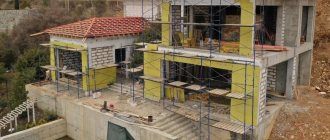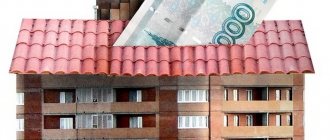In the modern world, transactions involving the purchase of real estate regularly occur. In order to avoid getting into an unpleasant situation, you need to be thoroughly prepared for such a transaction. Many people are interested in what the total area of a room or apartment is, and how this indicator is determined. This question is especially important for those who plan to sell or buy real estate in the near future.
Practice shows that this indicator directly affects the cost of housing. The larger the total area, the correspondingly higher the cost of housing. However, here it is necessary to understand all the features regarding the size of the living space. Only then will you be able to essentially assess how well the chosen apartment meets the requirements.
Main components
You may be interested in: Why do you need a current account for an individual entrepreneur? Cashless payment for individual entrepreneurs. Where is it more profitable to open a current account for individual entrepreneurs?
The calculation of the total area of the apartment is carried out according to several indicators. Three characteristics can be distinguished:
- living space;
- general;
- apartment area.
You may be interested in: Transport tax for 150 liters. With. - calculation formula and payment terms
Without taking into account these indicators, it is impossible to say exactly what residential real estate is. Therefore, when purchasing, be sure to clarify this information. If you know what is included in each type of room area, then you will not be afraid of deception when concluding real estate transactions.
Commentary to Art. 15 Residential Complex of the Russian Federation
1. In accordance with the most common point of view, the object of the legal relationship is what this legal relationship is about. Housing legal relations arise regarding residential premises. Therefore, Part 1 of the commented article states that the objects of housing rights are residential premises.
2. An isolated premises intended for the residence of citizens is considered residential. Traditionally, isolated premises are those that have autonomous access to common areas (corridor, hallway, landing, etc.) or to the street (see also commentary to Article 16 of the Housing Code).
3. At first glance, the indication that a residential premises is recognized as an isolated premises, which is real estate, is devoid of legal content. Moreover, by virtue of Art. 1 of the Federal Law of July 21, 1997 N 122-FZ “On state registration of rights to real estate and transactions with it” (hereinafter referred to as the Law on Registration of Rights), residential premises are classified as real estate. However, this instruction makes sense. ——————————— NW RF. 1997. N 30. Art. 3594.
Unfortunately, a considerable number of citizens still live in prefabricated houses, trailers, beams, etc. Such objects are not real estate (there is no strong connection with the land). Relations regarding their use for living are not regulated by housing legislation (in appropriate cases, the norms of civil law on property lease (lease) agreements are applied). This is precisely what is emphasized by the indication that the living quarters, i.e. a thing that is the object of housing rights is recognized as a premises related to real estate.
4. Only those premises that are suitable for permanent residence of citizens are considered residential. Here (in Part 2 of the commented article) it is explained in which cases an apartment, house and other premises are considered suitable for permanent residence - they must meet established sanitary and technical rules and regulations, and other legal requirements. To resolve the issue of compliance of a particular premises with these requirements, materials from the technical inventory bureau, sanitary and epidemiological services, conclusions of technical (and other) examinations, etc. are used.
5. The procedure for recognizing premises as residential and the requirements that residential premises must meet are established by the Government of the Russian Federation, which, by Resolution No. 47 of January 28, 2006, approved the Regulations on recognizing premises as residential premises, residential premises unsuitable for habitation and an apartment building as unsafe and subject to demolition or reconstruction.
The effect of this Regulation applies to residential premises in operation located on the territory of Russia (clause 2), regardless of the form of ownership and does not apply to residential premises located in capital construction projects, the commissioning of which and registration with the state have not been carried out in in accordance with the Town Planning Code of the Russian Federation (clause 3).
6. The recognition of a premises as residential, suitable (unsuitable) for citizens to live in, as well as an apartment building as unsafe and subject to demolition or reconstruction is carried out by an interdepartmental commission created for these purposes.
Depending on the type of housing stock by form of ownership, the interdepartmental commission is created, respectively, by the federal executive body, the executive body of the subject of the Federation, or the local government body. The commission includes representatives of the body that decided to create it, as well as representatives of bodies authorized to carry out state control and supervision in the areas of sanitary-epidemiological, fire, industrial, environmental and other safety, consumer rights protection and human well-being, to carry out inventory and rehabilitation of real estate objects. Where necessary, representatives of architecture, urban planning and other relevant organizations are also involved.
The owner of the residential premises (the person authorized by him) is involved in the work of the commission with the right of an advisory vote, and, in necessary cases, experts from design and survey organizations with the right of a casting vote.
A representative of the body that made the decision to create it is appointed as the chairman of the commission (clause 7 of the said Regulations).
A local government body has the right to make a decision on recognizing private residential premises located on the relevant territory as suitable (unsuitable) for citizens to live in and delegate to an interdepartmental commission the authority to assess the compliance of these premises with established requirements and to make a decision on recognizing these premises as suitable (unsuitable) for living. citizens (clause 8 of the Regulations). ——————————— The given instructions on the powers of the interdepartmental commission contained in the Regulations under consideration appear to be contrary to the law. Thus, the recognition of residential premises of the housing stock of a subject of the Federation as unsuitable for habitation is the responsibility of the state authorities of the subject of the Federation (Clause 6, Article 13 of the Housing Code). The recognition of residential premises of the municipal housing stock as unsuitable for habitation must be carried out by local government bodies (clause 8, part 1, article 14 of the Housing Code). It is clear that the interdepartmental commission cannot be considered either a state authority or a local government body (strangely, the Resolution of the Plenum of the Armed Forces of the Russian Federation dated July 2, 2009 refers to this commission as a body (clause 22)).
7. The said Regulations define in sufficient detail for an act of this level the requirements that a residential premises must meet. In particular, requirements are formulated for the load-bearing and enclosing structures of residential premises (clause 10), the arrangement and equipment of residential premises and the common property of premises owners in an apartment building (primarily in order to prevent the risk of injury, ensure the convenience and safety of movement and accommodation (clause 11)), engineering systems (clauses 12 - 14), etc. The regulation stipulates that residential premises, as well as premises that are part of the common property of premises owners in an apartment building, must be protected from the penetration of rain, melt and ground water and possible domestic water leaks from engineering systems (clause 16); access to residential premises located in an apartment building above the fifth floor, with the exception of the attic floor, must be provided using an elevator (clause 17); placement of residential premises in the basement and ground floors is not allowed (clause 23); placement of a toilet, bathroom (shower) and kitchen above the rooms is not allowed (equipment of a toilet, bathroom (shower) on the upper level above the kitchen is possible in apartments located on two levels (clause 24), etc.
This is important to know: Money secured by an apartment from a private investor
The Regulations also contain requirements for space-planning solutions for residential premises (clause 20), insolation (clause 21), height of premises (clause 22), electric field strength, magnetic field induction (clause 30), etc. At the same time Regulatory and technical instructions are often formulated. Thus, in a living room at a distance of 0.2 m from walls and windows and at a height of 0.5 - 1.8 m from the floor, the electric field strength of an industrial frequency of 50 Hz and the magnetic field induction of an industrial frequency of 50 Hz should not exceed 0.5, respectively kV/m and 10 µT (item 30); inside a residential premises, the equivalent radiation dose rate should not exceed the dose rate permissible for an open area by more than 0.3 μSv/h, and the average annual volumetric activity of radon in the air of operated premises should not exceed 200 Bq/cubic meter. m (clause 31).
Naturally, reference standards are also used to determine the requirements that residential premises must meet. Thus, in a residential area, permissible levels of vibration from internal and external sources during the day and at night must correspond to the values established in the current regulatory legal acts (clause 27). Similar guidance is given regarding the permissible level of infrasound (clause 28).
In some cases, requirements are defined by reference while setting a limit. For example, in a residential building, permissible sound pressure levels in octane frequency bands, equivalent and maximum sound and penetrating noise levels must correspond to the values established in regulatory legal acts, and not exceed the maximum permissible sound level in rooms and apartments during the daytime - 55 dB , at night - 45 dB (p. 26).
Sometimes requirements for residential premises are formulated using rating categories. Thus, the load-bearing and enclosing structures of a residential premises must be in a working condition in which violations that arise during operation, in particular deformability (and in reinforced concrete structures - crack resistance), do not lead to disruption of the operability and load-bearing capacity of the structures, the reliability of the residential building and ensure safe stay of citizens and safety of engineering equipment (clause 10).
Thus, determining whether a premises meets the requirements for residential premises is a rather complex process. You have to refer to a large number of regulations, conduct examinations, measurements, etc. and so on.
8. In the case when a residential house (building) is erected in accordance with the procedure established by law and put into operation, such an act as recognizing this house (premises located in it) as residential (residential) is not required. Recognition of a premises as residential in this case is limited to actions that mediate its commissioning (including checking whether it meets the requirements for residential premises), state registration and state registration of the right to it (as a residential premises).
From the above it follows that the rules contained in the above-mentioned Regulations, approved in pursuance of the instructions of Parts 3 and 4 of the commented article, apply in the following cases.
Firstly, when deciding on the transfer of non-residential premises to residential ones. In particular, such a transfer is unacceptable if the corresponding premises do not meet the established requirements or there is no opportunity to ensure compliance with the requirements (Part 4 of Article 22 of the Housing Code).
Secondly, when establishing whether the premises used as housing and, from a legal point of view, are considered residential premises, are suitable for living.
Thirdly, when deciding on the recognition of an apartment building in operation as unsafe and subject to demolition.
9. Earlier we talked about the objective, relatively speaking, grounds for recognizing residential premises as suitable (unsuitable) for living. Apparently, it is also necessary to highlight subjective circumstances that may indicate the suitability (or unsuitability) of a particular residential premises for the residence of specific persons. The Regulations, in particular, establish that separate residential premises may be considered unsuitable for residence of “disabled people and other low-mobility groups of the population who use wheelchairs due to illness” (clause 54). It seems that residential premises should be recognized as unsuitable for living by certain categories of citizens in the presence of “medical criteria”, regardless of whether wheelchairs are required, whether these citizens have them and whether they use them.
10. Summarizing what was stated when commenting on the rules contained in parts 3, 4 of this article, it can be noted that the basis for declaring a residential premises unsuitable for habitation is the presence of identified harmful factors in the human environment that do not allow ensuring the safety of life and health of citizens due to deterioration of the building as a whole or its individual parts, operational characteristics leading to a decrease in the reliability of the building, the strength and stability of building structures and foundations to an unacceptable level.
Residential premises that have a high percentage of physical wear and tear are considered unsuitable for living; located in sanitary protection, fire and explosion hazardous industrial zones, in hazardous areas of rock dumps of coal, shale mines and processing plants, areas of landslides, mudflows and snow avalanches, in territories annually flooded by flood waters; after an accident, fire, natural or man-made disaster, if restoration work is technically impossible or impractical from an economic point of view, etc.
11. In previous legislation, legal significance was usually attached not to the entire (total) area of an apartment or residential building, but only to the living area. It included only the area of the actual living quarters (rooms) and did not take into account the area of the hallway, corridor, kitchen, bathroom, etc. (according to previously accepted terminology - “utility rooms and common areas”). Currently, these facilities are referred to in the Housing Code of the Russian Federation (including in Part 5 of the commented article) as “premises for auxiliary use, intended to satisfy citizens’ household and other needs.” For example, housing was provided within the standard living area, i.e. no more than 12 sq. m of living space for each family member (Article 40 of the RSFSR Housing Code). Only living space was paid (the size of utility rooms and common areas did not matter).
In recent years, in various legal acts (including federal laws), legal significance has increasingly been given not to residential space, but to the total area of residential premises (apartments, houses). In the Housing Code of the Russian Federation, this trend has received complete design. Thus, the accounting norm and the provision norm are established based on the total (and not residential) area of the residential premises (see Article 50 of the Housing Code and the corresponding commentary). The amount of payment for rent, maintenance and repair of residential premises for tenants under social tenancy agreements and commercial rental agreements for residential premises of state and municipal housing funds is determined based on the occupied total area of the residential premises (see Part 2 of Article 156 of the Housing Code and commentary to her).
This is important to know: Is a disabled person of group 1 entitled to an apartment?
In this regard, it is necessary to establish what is included in the total area of an apartment or other object of housing rights. This problem is solved in part 5 of the commented article. The essence of the norm contained in it is that the total area includes everything that forms a given object of housing rights (living rooms, hallway, corridor, kitchen, dressing room, bathroom, toilet, etc.), with the exception of the objects indicated here (balconies , loggias, verandas and terraces). The list of exceptions is formulated imperatively and as exhaustive, i.e. no other federal law, other legal act or agreement can change or supplement it.
total area
What do you need to know about this? The first thing you should decide on is the total area of the apartment. These may or may not be habitable. These may simply be premises that are directly related to the proposed property. Often sellers and real estate agents resort to tricks and indicate the total area of the premises as living space. This is not entirely true, since it also includes balconies and loggias. Therefore, this parameter must be specified separately.
Nuances of calculating total and living space
There are several ways to find out the total area of an apartment:
- View the object data in the Unified State Register of Real Estate. To do this, it is enough to know the exact address of the property.
- Calculate yourself. It is necessary to calculate the area of all rooms (except for the balcony and loggia), for which measure the lengths of the two walls that form each of them and multiply them.
How to calculate the living area of an apartment, knowing the total: subtract from it all non-residential premises: kitchen, bathroom, corridors, storage rooms.
In order not to overpay when buying a home and to sell real estate more profitably, you must be aware of the latest relevant information on housing laws. This will help you save money and protect your interests in controversial issues.
Living space
Let's look at this in more detail. What applies to the living space of an apartment? First of all, you need to know what is meant by this term. Living space, as you might guess, is a space suitable for human habitation. It would seem nothing complicated. However, many have difficulty answering what is included in this area.
You will be interested in: Residential complex "Bereg", Khimki - review, features, layout and reviews
To fully understand what each of the three areas includes, you need to consider one more concept - the area of the apartment. This refers to the entire room. This includes both a balcony and a loggia. Such space is still considered useful. The concept of usable area also includes various mezzanines. It is important to avoid confusion here. In foreign countries, usable area refers to all residential premises used.
The difference between the living area and the total area of the apartment
Often homeowners use the terms “living area” and “total area” of a house or apartment, not quite understanding that these are different concepts. There is nothing wrong with this if the conversation is not of a business nature or the issue of a real estate transaction is not resolved. When a person independently, that is, without the involvement of realtors or competent organizations, is engaged in the search or sale of housing, then understanding the terminology becomes a matter of principle and legal significance.
Components
The total area of the apartment is not only the premises suitable for living. Living space includes only rooms. The larger they are, the higher this indicator. It is worth considering that the bathroom does not belong to the living space, since you cannot live in it. Although this is a necessary place in any apartment.
It should also be noted that the kitchen is not included in the living area. This is not entirely correct from a logical point of view, but it is better to take this feature into account. Many sellers today are trying to increase the size of their living space by adding a kitchen, as well as loggias and bathrooms.
Calculation for a communal apartment
The law establishes the payment procedure for communal apartments. They are contained in Art. 41 – 43 Housing Code of the Russian Federation. Only rooms are considered living space in a communal apartment. The corridor, kitchen, and bathroom are common property. Calculation of utility bills for persons living in a communal apartment is calculated based on their shares in the living area of the property.
At the same time, the size of the room and common property of a communal apartment is not relevant to the calculation of the share in the common property of an apartment building.
Calculation rules
As you already understand, living space is considered the main indicator influencing the value of real estate. Let's try to figure out how it is calculated. This point is very important. A component of this space is the room in which you can live. Therefore, to calculate the living area of a room, it is enough to simply add together the footage of all the rooms. The result should be the required indicator. To calculate the area of a room, you should use simple mathematical formulas. Measurements are taken on the inside of the baseboard.
How is the area calculated in a new building?
It is not surprising that with such an abundance of terms and their interpretations, controversial situations may arise.
Most often, this happens when purchasing apartments under a shared construction agreement, at the conclusion of which the developer provides a description of the shared participation object (apartment), based on data from the design documentation for the house. The design and construction of multi-apartment residential buildings under construction are carried out on the basis of SNiP 31-01-2003, in which the calculation of areas is proposed to be carried out in accordance with the Instructions on the registration of housing stock. It is also used when measuring an apartment for cadastral registration, i.e. the total area is calculated using reduction factors.
But there is one nuance: what figure to take as a basis when calculating the cost of an apartment in a new building is specified in the equity participation agreement. This depends on the developer’s marketing policy: you can take a living space, and then a square meter will cost more. Or you can reduce the cost per square meter to attract buyers, taking the total area as a basis.
However, this cheapness will turn out to be imaginary, because it is compensated by the larger footage. So, you need to carefully study the DDU in order to understand what area will be taken into account when determining the cost of the apartment, otherwise it is unlikely that you will be able to prove the developer wrong. It is possible to make a claim only if the actual area of the apartment differs from that indicated in the document, then the shareholder has the right to demand the return of money for unfinished meters.
What rooms are included in the total area?
Let's look at this in more detail. Often when purchasing residential real estate, the question arises: is the loggia included in the total area of the apartment? It is advisable for everyone to know this, since this indicator plays a fairly important role. It can be used to judge how much space is allocated for the needs of residents, and not just for living. Such premises include:
- toilet;
- bathroom;
- hallway;
- bedrooms;
- living room;
- wardrobe;
- other utility rooms.
Loggias and balconies should not be added to the total area of the premises. Based on the Housing Code of the Russian Federation, the rooms in question do not belong to the apartment at all. Often buyers are not aware of this norm, which leads to negative consequences.
You may be interested in: Is it possible to donate change to Sberbank? Exchange of small coins for banknotes at Sberbank: options and procedure
How is the area of stairs and niches calculated? They can be included in the common space of the apartment, but under certain conditions. In addition to premises, this indicator includes:
- niches whose height is at least 2 meters;
- stairs located in the apartment and the space under them;
- arches more than 2 meters high;
- protruding elements.
What is included in the total area of an apartment according to the law?
In accordance with paragraph 5 of Art. 15 of the Housing Code of the Russian Federation, the total area of an apartment is considered to be the total value of all premises in it, including rooms and auxiliary premises. This is the footage of the apartment as a whole, excluding structures protruding beyond the walls of the house (loggias, balconies, verandas and terraces).
According to the law, the total area consists of the areas of the following internal components of the apartment:
- living rooms (living room, bedroom, children's room), their area is the residential component;
- kitchens;
- corridor;
- niches, storage rooms, built-in wardrobes;
- bathroom;
- walls and partitions as parts of rooms inside the apartment.
Differences between areas
This aspect needs to be given special importance. How is the total area of a two-room apartment determined? What indicators are taken into account? There are certain differences between the living area and the common area that should definitely be taken into account. These include:
- Number of square meters: living area is only a component of the total. For this reason, its footage should be much smaller. Sometimes these indicators may differ from each other by a factor of two.
- Premises included in the total area: living rooms include rooms for sleeping and relaxation (bedrooms, children's rooms, guest rooms). General covers all rooms in the apartment.
- Possibility of use: the possibility of receiving subsidies, adopting a child, and so on depends on the size of the living space. The total area affects the market value of housing, the amount of utility bills and the amount of contributions for major repairs.
What role does the square footage of an apartment play?
The following points depend on the size of the total area of the apartment.
Property value
If you don't read advertisements for apartments for sale too carefully, you can make your life much more difficult.
Often sellers indicate the total area of the apartment, and the potential buyer imagines a large mansion. Therefore, it is so important to clarify the living area of the room.
Then you can avoid such situations when, due to inattention, the buyer signs a share participation agreement, and then regrets that he overpaid a considerable amount for the common living space, receiving a luxurious kitchen, a large combined bathroom and a tiny bedroom.
Calculation of heating charges
Heating radiators can be found not only in living rooms, but also in domestic premises. Therefore, the amount of utility bills in this case is calculated based on the total area.
If the owner decides to do the heating himself using electricity or gas, then to calculate the profitability of such actions the total square footage will always be taken.
Payment for general house needs
If a person has a large apartment, he will be considered a large owner . This means that he will pay more for major repairs than the owner of a small living space.
In this case, the size of the apartment will be calculated taking into account the total area.
It may turn out that the owner of an apartment with a large kitchen and a spacious combined bathroom will have to pay much more than the owner of a one-room apartment with a tiny kitchen but a large bedroom.
Comfortable stay
The larger the living area of the apartment, the more spacious and comfortable the bedrooms and living rooms will be.
In which rooms can furniture of any size be placed and equipped taking into account the basic needs of the owners. The general area is no less important, since it includes the main places for storing a large number of things.
If the apartment has a large corridor, then children can play there comfortably. You can put all unnecessary things in the pantry. The common area also includes the kitchen, where people spend a huge amount of time.
Instructions for calculating the area of an apartment
So what do you need to know about this? Today, many are interested in how the total area of a 2-room apartment is calculated. In order to independently determine this characteristic of the room, you will need:
To learn how to take measurements yourself, you will need a tape measure and a calculator. It will be more convenient to take measurements if someone helps you.
First, draw a diagram of the apartment on a piece of paper. This will make it easier for you to enter the values on the plan. Don’t forget to take measurements in utility rooms – corridors, closets, and so on. It is necessary to measure the length of the premises according to the level of the baseboard. To do this, make sure that the tape measure is tensioned well and accurately. The sums of all measurements must be converted into meters and written down on a piece of paper. If the room has an irregular shape with protrusions, corners and curves, then it will be easier to divide the plan into separate figures and indicate their sizes on the diagram.
The length and width of each room should be multiplied and recorded on the plan. When you add up the areas of all the rooms, you should get a total.
Commentary to Art. 15 Residential Complex of the Russian Federation
1. Residential is understood as an isolated premises, which is real estate and is suitable for permanent residence (meets established sanitary and technical rules and regulations, and other legal requirements). It follows from this that residential premises are intended for the residence of citizens. They can be in state ownership (Article 214 of the Civil Code of the Russian Federation), municipal property (Article 215 of the Civil Code of the Russian Federation), in the ownership of citizens and legal entities (Article 213 of the Civil Code of the Russian Federation), which is reflected in Part 2 of Art. 19 Housing Code of the Russian Federation.
Let's consider the characteristics of the object of housing rights.
Firstly, this is an isolated room.
However, let us turn to Art. 76 of the Housing Code of the Russian Federation, according to which the tenant of a residential premises under a social tenancy agreement has the right to sublease part of the residential premises, i.e. and part of the room.
Thus, the object of housing rights can be not only an isolated premises; whereas the subject (object) of a housing rental agreement can only be an isolated residential premises (Article 62 of the Housing Code of the Russian Federation, Article 673 of the Civil Code of the Russian Federation).
Secondly, this is a living space. A necessary characteristic of housing is its purpose for the residence of citizens. This position is contained in Art. 17 Housing Code of the Russian Federation (Part 1). Only a room that is functionally intended for living is considered residential. Article 288 of the Civil Code of the Russian Federation (clause 2) establishes: “Residential premises are intended for the residence of citizens.”
Hotels, sanatoriums, holiday homes, boarding houses, etc. have a different functional purpose, i.e. are a place of rest and treatment. Such premises are used for temporary stay, as opposed to a place of residence. Place of residence according to Art. 20 of the Civil Code of the Russian Federation recognizes the place where a citizen permanently or primarily resides.
Thirdly, this is a premises suitable for permanent residence. This means that in terms of area, layout, illumination, insolation, microclimate, air exchange, levels of noise, vibration, ionizing and other radiation, it must comply with sanitary rules in order to ensure safe and harmless living conditions (Article 23 of the Federal Law of March 30, 1999 N 52-FZ “On the sanitary and epidemiological welfare of the population”). In addition to sanitary rules, residential premises must comply with technical rules and regulations, other legal requirements: stationary structure, the presence of certain types of amenities, auxiliary premises, etc.
2. The commented article does not mention such a requirement as landscaping. However, what is important for a person is the comfort of living, the sum of the consumer qualities of housing. An essential part of comfort is landscaping. It follows that a residential premises must meet not only sanitary and technical requirements, but also a certain degree of improvement in order for it to be the object of housing rights.
Requirements to provide residential premises with certain types of “improvement” are contained in the Regulations on the recognition of premises as residential premises, residential premises unsuitable for habitation and an apartment building as unsafe and subject to demolition, approved. Decree of the Government of the Russian Federation dated January 28, 2006 N 47.
The degree of improvement in cities and other settlements varies. In this regard, the wording of Art. 40 of the Housing Code of the RSFSR (“Requirements for residential premises”): residential premises provided for citizens to live in must be well-equipped “in relation to the conditions of a given locality.”
3. The procedure for recognizing a premises as residential and the requirements that it must meet are established by the Government of the Russian Federation (Part 3 of the commented article). The grounds and procedure for recognizing residential premises as unfit for habitation are also established by the Government of the Russian Federation (Part 4 of the commented article).
The Government of the Russian Federation adopted Resolution No. 47 of January 28, 2006, which approved the Regulations on recognizing premises as residential premises, residential premises unsuitable for habitation and an apartment building as unsafe and subject to demolition or reconstruction.
According to this Regulation, residential buildings and residential premises are considered unsuitable for living: having a certain physical wear and tear; in disrepair; in which the harmful effects of environmental factors have been identified (Section III of the Regulations).
Thus, unsuitability is determined by the degree of deterioration of housing (the extreme degree is the accident rate), namely: the presence of irreparable faults in utility networks, non-compliance with building codes when developing the territory close to the house, etc.
The criteria for classifying housing as unsuitable due to the harmful effects of environmental factors are provided for by state sanitary and epidemiological rules and regulations.
Issues regarding the recognition of residential buildings (residential premises) as unfit for habitation are resolved by interdepartmental commissions.
The federal executive body creates, in accordance with the procedure established by it, a commission to evaluate residential premises of the housing stock of the Russian Federation. The commission includes representatives of this federal executive body. An official of the specified federal executive body is appointed as the chairman of the commission.
In the same way, they create their own commissions: the executive body of the constituent entity of the Russian Federation - to assess the residential premises of the regional housing stock; local government body - to assess the residential premises of the municipal housing stock.
The owner of the housing stock or a representative of the owner performing the functions of managing the housing stock, in relation to the residential building (residential premises) of which the issue of declaring it unfit for habitation, and, if necessary, a representative of design and survey organizations, should be involved in the work of the commission, who carried out the inspection of this residential building (residential premises).
The commission, based on an application from the owner of the premises or an application from a citizen (tenant) or on the conclusion of state control and supervision bodies, assesses the compliance of the premises with the requirements established in the Regulations.
After studying the submitted documents, the list of which is provided for in clause 45 of the Regulations, and, if necessary, inspecting the residential building (residential premises), the commission makes a decision:
on the suitability of a residential building (residential premises) for living;
on the need and possibility of carrying out major repairs, reconstruction or redevelopment (if necessary, with a feasibility study) in order to bring the characteristics of the residential premises lost during operation into compliance with the requirements established in the Regulations and after their completion - on the continuation of the assessment procedure;
This is important to know: Use of common property in an apartment building
on the unsuitability of a residential building (residential premises) for habitation, indicating defects that cannot be eliminated technically or the elimination of which is not economically feasible, and the criteria for unsuitability;
on recognizing an apartment building as unsafe and subject to demolition or reconstruction (clause 47).
The decision of the commission can be appealed by interested parties in court.
If a residential building (residential premises) is declared unfit for habitation due to an emergency condition or the harmful effects of environmental factors that pose a particular danger to the life and health of people, the decision must indicate to the owner (a person authorized by the owner) the need to immediately resettle citizens.
4. In accordance with Part 5 of the commented article, the total area of a residential premises consists of the sum of the areas of all parts of such premises, including the area of auxiliary premises intended to satisfy citizens’ household and other needs related to their residence in residential premises, with the exception of balconies, loggias, verandas, terraces.
Loggias and balconies
What do you need to know about them? Many people believe that the loggia is included in the total area of the apartment, but the balcony is not. Although the differences between these two concepts are unclear, they should not be ignored, as this can lead to serious legal consequences. By uniting, residents of the house can donate the outer part of the loggias and balconies for use for advertising purposes. In some cases this brings good income.
How to determine
To find out what the living area is, you need to calculate the number of square meters of the entire space intended for living. This:
To obtain the quantity, each space is calculated separately. For example, in a one-room apartment this area is proportional to the parameters of the only room - the bedroom-living room, in a two-room apartment - the bedroom and living room.
Important! Some people mistakenly attribute the kitchen or loggia to this space. But according to the Housing Code, this is a mistake
The dining area cannot be considered suitable for living, even if there is a bed there.
Non-residential area - the remaining space, including a corridor, kitchen, bathroom (bathtub and toilet), balcony, loggia. This includes storage rooms, hallways, and dressing rooms.
Everything is included The cost of repairs includes everything: work, materials, documents.
Without your participation After agreeing on the project, we only bother the owners when the repairs are completed.
The price is known in advance. The cost of repairs is fixed in the contract.
Fixed repair period Turnkey apartment renovation in 3.5 months. The term is fixed in the contract.
Controversial issues
It is advisable to familiarize yourself with them first. How is the total area of an apartment determined? Should balconies and loggias be taken into account in the calculation? How are different situations regulated? There are two main legislative acts that regulate the determination of housing area. This:
- housing code 2005;
- SNiP 2003 “Residential multi-apartment buildings”.
It should also be taken into account that some of the provisions described in these documents were declared repealed in 2009 by Federal Law 384-FZ. Let's go through the main important points of the housing code:
- Art. 15, paragraph 5 - the basis for calculations of residential premises. The total area of the apartment consists of the sum of all areas. This includes rooms and utility rooms that are designed to meet the needs and requirements of the apartment owners. Terraces, balconies, loggias and verandas are not included in the total area.
- Art. 16, paragraph 1 – definition of types of residential premises: residential buildings or parts thereof, apartments, rooms.
- Art. 16, paragraph 3 – formulates the concept of an apartment as a structural room that is separate in nature and located in an apartment building, with direct access to common areas. The components of an apartment are one or more rooms, auxiliary premises designed to satisfy household needs.
According to the above SNiP, the determination of the total area of the apartment put into operation is based on the external dimensions. Here we are already talking about including a balcony and loggia.
When calculating area, it is recommended to use the following coefficients:
- 0.5 for the loggia;
- 0.3 for balconies and terraces;
- 1 for cold storerooms and verandas.
It should be borne in mind that SNiPs are not the main document. The Housing Code in this case is more important, and you should focus exclusively on it.
Many officials today insist on adding extra square meters to the living area. Therefore, property owners are interested in whether the loggia is included in the total area of the apartment. If the calculations are based on the 2003 standards, then such a possibility is provided there. However, one should still be guided by a more important document, such as the Housing Code of the Russian Federation. According to this regulatory act, the balcony is excluded from the total area of the residential premises.
According to the Housing Code and SNiP, partitions are considered part of the main and auxiliary premises, therefore their size is part of the total area of the apartment in sq. m.
In our country, current laws and regulations change quite often, so there can be a lot of questions related to determining the area of living space. Most of the features of calculations are regulated by various documents and regulations, which may contradict each other. This can cause certain difficulties for ordinary people.
How to calculate area?
Since the owner himself can calculate the area of the apartment, there is no need to spend extra money on the services of private companies.
The area is calculated as follows:
- total area – living rooms + utility rooms + balconies, loggias;
- living space - bedrooms, guest rooms + kitchen, corridor, loggia (if redevelopment has been carried out and the apartment has been made into a studio).
Important! When making calculations, it is necessary to take into account the reduction factor: balconies, terraces - 0.3%, loggias - 0.5%, verandas and cold storage rooms - 1%.
Buyers' rights
This aspect deserves special attention. Questions about the rules for calculating the area of residential premises often arise when purchasing housing in new buildings. Controversial situations often arise. For example, a buyer, purchasing housing from a developer, signs a contract for the purchase of an apartment with an area of 77 square meters including a loggia. At the same time, the contract did not contain references to the coefficients used in the calculations.
As a result, after putting the apartment into operation, the buyer receives a technical passport with the value of the total area of the apartment indicated in it: 72.5 square meters. m. Thus, it turned out that the seller cheated and, when drawing up the contract, did not indicate the coefficient by which the loggia was taken into account. In this case, the buyer has the right to appeal to the courts.
What does the area of the apartment affect?
The legislator distinguishes three types of residential premises:
The total area of the residential premises is used for the following purposes:
- heating fee ;
- calculating the homeowner’s share in the common property of an apartment building (the share is proportional to the size of the total area);
- calculation of the tax base when paying tax on land located in common shared ownership (proportional to the size of the total area);
- calculating the tax base when paying tax on residential premises and tax deduction for property tax for individuals;
- determining the cost of 1 m 2 of total area when transferring residential premises to citizens if their previous home is recognized as unsafe and included in the regional program for relocating citizens from unsafe housing stock;
- determining the standard for providing housing;
- determining the accounting standard for residential premises based on the size of which, the level of housing provision for citizens is determined;
- determining the size of housing space allocated under a social rental agreement or for ownership of various categories of persons (military personnel, disabled people, orphans, etc.);
- calculating the amount of gratuitous social payments for housing using federal budget funds.
At the moment, 28 constituent entities of the Russian Federation have switched to this order, including Moscow, Buryatia, Bashkortostan, Vladimir, Ivanovo regions, etc. In connection with this change in the procedure for calculating tax, the tax burden on citizens increases, so the legislator established deductions (tax-free areas) for residential properties in the amount of 20 m 2 of total area for an apartment, 10 m 2 for a room, 50 m 2 - for home.
This is important to know: Is it necessary to privatize a garden house or country house scrap on a privatized plot?
Determining the size of living space is advisable for:
- determining the size of the sanitary standard for housing;
- provision of housing in a hostel (at least 6 m2 per person) (Article 105 of the Housing Code of the Russian Federation);
- housing assessments for concluding a real estate purchase and sale agreement;
- drawing up an act of inspection of the living conditions of a minor by the guardianship and trusteeship authorities;
- concluding a mortgage ;
- drawing up a transfer and acceptance certificate under contracts of sale, exchange, rent, social tenancy.
Determining the area of the premises is carried out for the purposes of:
- determining the size of housing owned by a citizen when providing him with an apartment under a social tenancy agreement;
- statistical accounting of the housing stock in the Russian Federation, calculating the amount of payment for housing and utilities, determining the social standard of housing and other purposes;
- calculating the cost of payment for general house needs;
- calculating the amount of subsidies for housing and utilities.
Thus, the three categories of residential premises are used for different purposes and it is important to determine when and which category is used in accordance with the legislation of the Russian Federation.
